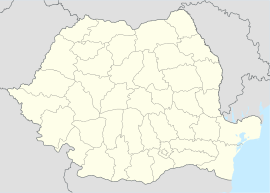world.wikisort.org - Romania
Târgu Ocna (Romanian pronunciation: [ˌtɨrɡu ˈokna]; Hungarian: Aknavásár) is a town in Bacău County, Romania, situated on the left bank of the Trotuș River, an affluent of the Siret, and on a branch railway which crosses the Ghimeș Pass from Moldavia into Transylvania. Târgu Ocna is built among the Carpathian Mountains on bare hills formed of rock salt.[3] In fact the English translation of Ocna is salt mine.
Târgu Ocna | |
|---|---|
Town | |
 Coat of arms | |
 Location in Bacău County | |
 Târgu Ocna Location in Romania | |
| Coordinates: 46°16′48″N 26°37′12″E | |
| Country | Romania |
| County | Bacău |
| Government | |
| • Mayor (2020–2024) | Cristian-Aurelian Ciubotaru[1] (PSD) |
| Area | 48.90 km2 (18.88 sq mi) |
| Population (2011)[2] | 11,300 |
| • Density | 230/km2 (600/sq mi) |
| Time zone | EET/EEST (UTC+2/+3) |
| Vehicle reg. | BC |
| Website | orasul-targuocna |
Târgu Ocna's main industry is salt production, as it is the largest provider in Moldavia. Other industries include wood processing, coal mining, steel producing, and petroleum-based industries.
The town administers two villages, Poieni and Vâlcele.
| Year | Pop. | ±% |
|---|---|---|
| 1900 | 8,033 | — |
| 1912 | 7,989 | −0.5% |
| 1930 | 12,588 | +57.6% |
| 1948 | 9,796 | −22.2% |
| 1956 | 11,227 | +14.6% |
| 1966 | 11,647 | +3.7% |
| 1977 | 12,603 | +8.2% |
| 1992 | 16,071 | +27.5% |
| 2002 | 14,184 | −11.7% |
| 2011 | 11,300 | −20.3% |
| Source: Census data | ||
Natives
- Gabriela Adameșteanu, writer
- Sorin Antohi, political scientist
- Miron Grindea, journalist
- Dan Iuga, pistol shooter
- Costache Negri, writer
- Mihăiță Nițulescu, boxer
- Ion Talianu, actor
- Traian Vasai, painter
References
- "Results of the 2020 local elections". Central Electoral Bureau. Retrieved 8 June 2021.
- "Populaţia stabilă pe judeţe, municipii, oraşe şi localităti componenete la RPL_2011" (XLS). National Institute of Statistics.
- One or more of the preceding sentences incorporates text from a publication now in the public domain: Chisholm, Hugh, ed. (1911). "Tîrgu Ocna". Encyclopædia Britannica. Vol. 26 (11th ed.). Cambridge University Press. p. 1010.
Wikimedia Commons has media related to Târgu Ocna.
На других языках
[de] Târgu Ocna
Târgu Ocna (deutsch veraltet Stadt Okna, ungarisch Aknavásár) ist eine Stadt im Kreis Bacău in Rumänien.- [en] Târgu Ocna
[ru] Тыргу-Окна
Ты́ргу-О́кна (рум. Târgu Ocna, Tîrgu Ocna) — город в Румынии, жудец Бакэу. Центр соледобычи Румынии, бальнеоклиматический курорт.Текст в блоке "Читать" взят с сайта "Википедия" и доступен по лицензии Creative Commons Attribution-ShareAlike; в отдельных случаях могут действовать дополнительные условия.
Другой контент может иметь иную лицензию. Перед использованием материалов сайта WikiSort.org внимательно изучите правила лицензирования конкретных элементов наполнения сайта.
Другой контент может иметь иную лицензию. Перед использованием материалов сайта WikiSort.org внимательно изучите правила лицензирования конкретных элементов наполнения сайта.
2019-2025
WikiSort.org - проект по пересортировке и дополнению контента Википедии
WikiSort.org - проект по пересортировке и дополнению контента Википедии
